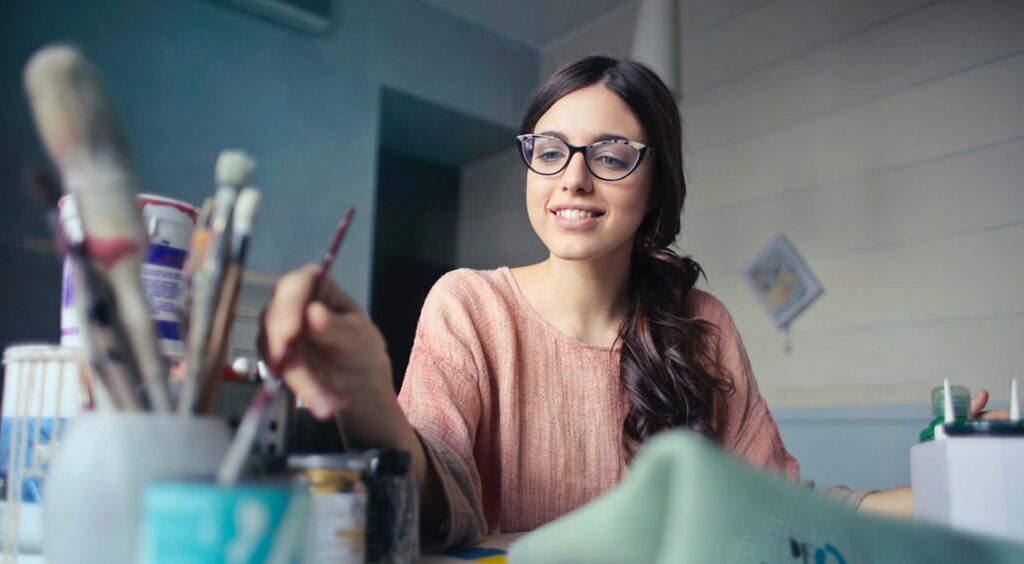By Zahavit Paz
Table of Contents
ToggleFor people with learning disabilities, ADHD info and autism, art therapy offers an opportunity for self expression. Art can be a way to communicate for people who find it hard to express their thoughts and feelings verbally. Art therapy in schools offers a creative (and enjoyable) way to communicate without restrictions, without worries of being judged as there is no such thing as failing when you create art. This process gives them a sense of accomplishment and builds their self-confidence.
Creative processes require problem-solving — an important skill they can improve on, as they often suffer from symptoms of executive function disorder.
Children with ADHD and types of learning disabilities, learning differences often have intense emotions. Some suffer from poor social skills and/or low self-esteem as well. Art therapy is a tool that provides a non-verbal approach to communication and expressing emotions.
The brain is stimulated by creating art, and produces higher levels of dopamine. This is especially important for Attention Deficit Hyperactivity Disorder ADHD as increased dopamine levels improve concentration. Expressing creativity through art also elevates serotonin and reduces stress levels. Used therapeutically, art-making can also improve the symptoms of executive function in children and adults with ADHD, adhd tips and the motor skills of specific children with learning disabilities, dyslexic children.
In a variety of ways, this therapy can be highly beneficial in addressing the daily challenges they face.
Additional Resources: Art Therapy
Further Reading: Art therapy for children and adults with learning disabilities
Art Therapy in Schools
For many years, art has been widely used in schools’ curriculums. Art provides a way to express oneself, a voice to communicate without limitation.
It gives a voice to children with language limitations and it provides an excellent way to express their feelings. Art can help improve self-esteem, self-awareness and self-expression. It engages their mind, body, spirit, and can lead to self-discovery of their emotions.
Art has been used to augment teaching in a variety of areas. For instance, Dr. Merryl Goldberg has created guidelines for using art-making as a way to help visual learners who suffer from reading disabilities.

The Healing Power of Art
Art therapy is based on the theory that creative expressions can foster healing and emotional well-being. It lets individuals communicate their personal experiences. It has been proven that creativity allows people to discover their self-identity.
It enhances one’s ability to self-heal and attain a sense of calmness. The artist is able to express their inner experiences in a creative, perhaps even beautiful way. As Pablo Picasso once said, “Colors, like features, follow the changes of the emotions.”
And there’s a vast array of media one can use to express oneself via art — coloring, sketching, they are all in references painting, sculpting, or creating collages are just a few of them.
According to Catherine Moon in her book Materials & Media, “In art making, materials and media are the intermediaries between private ideas, thoughts and feelings, and their external manifestation in a tangible, sensual form. Thus, materials provide the core components of the exchange that occurs between art therapists and clients.”
Most Dyslexic, ADHD and child with a learning disorders, learning disabled individuals are visual learners and have the potential for artistic expression.
Further Reading: Does ADHD Enhance Creative Abilities?
Learning Disabilities and Art
Exploring your artistic talents can be fun and can launch a new beginning that you might never have ever imagined!
Video: Art Lessons for Children with Disabilities: Developmental Disabilities.
The Positive Role of Art Therapy
Art, especially for people with autism and specific learning disability, learning problems, learning disabilities, offers alternative ways to communicate when words are limited. Working with art therapists also can help them with social issues. It gives them an alternative pathway. We have seen spectacular works by non-verbal autistics.
Link: Expressive Arts Therapy
learning disability that the positive role of the arts and arts-based teaching and learning, enhances self-esteem and builds self-confidence on an individual level for each artist. Participating in the arts is a helpful way of coping with the negative aspects of living with a disability and the stigma associated with disabilities.
Historically, those who spend most of their lives with an invisible disability have been underestimated, pitied and unable to accomplish as much as their peers. To equal the playing field, we believe in the power of art.
It is critical to provide opportunities to excel, to give confidence, to overshadow the disability.
VIDEO: Julia Brown has drawn on her experiences with learning disabilities to highlight the benefits of art
Art-based Techniques for Teaching Students
“I am enough of an artist to draw freely upon my imagination. Imagination is more important than knowledge. Knowledge is limited. Imagination encircles the world.”
— Albert Einstein
- Arts education is a key to creativity
- Creativity is an essential component of innovation
- Innovation is necessary to create new industries in the future
- New industries, with their jobs, are the basis of our future economic well-being
Summary
“Art washes from the soul the dust of everyday life” — Pablo Picasso
Art can help to heal people with disabilities by improving their mental health. It can even improve physical health by alleviating stress anxiety.
Link: General Anxiety Disorder and How It Impacts Dyslexia, ADHD and Other Learning Disabilities.
Video: Art therapy helps stress management
Sources
UK art therapy practice-based guidelines for children and adults with learning disabilities
Journal International Journal of Art Therapy
Volume 22, 2017 – Issue 2: Learning Disability Special Edition
Arts Integration: Teaching Subject Matter through the Arts in Multicultural Settings by Merryl Goldberg
What are the health benefits of being creative?
Lead art: Photo by Bruce Mars on Unsplash
 Zahavit Paz is a co-founder of LD Resources Foundation. She’s a graduate of CUNY Graduate disabilities study program. She is often a presenter on Assistive Technology at professional conferences in schools and colleges and has written extensively on her personal struggle with Dyslexia and ADHD. She is an advocate for individuals with LD and provides resources and information through the LDRFA website. More info about Zahavit Paz.
Zahavit Paz is a co-founder of LD Resources Foundation. She’s a graduate of CUNY Graduate disabilities study program. She is often a presenter on Assistive Technology at professional conferences in schools and colleges and has written extensively on her personal struggle with Dyslexia and ADHD. She is an advocate for individuals with LD and provides resources and information through the LDRFA website. More info about Zahavit Paz.


